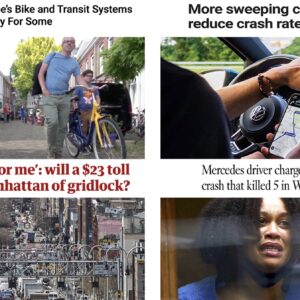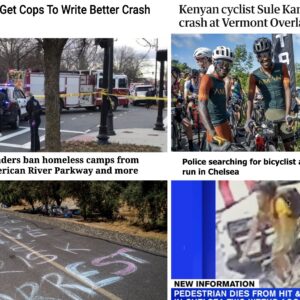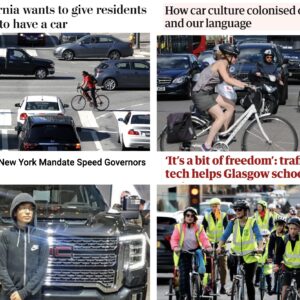Let’s get started shall we? Here’s the news and stories that caught our eyes this past week…
— So what really happened in terms of transportation behavior in New York after Sandy? The Rudin Center at NYU has released results of a survey. One takeaway: “Walking and biking commuters were, on average, the least frustrated.”
— Some people wonder why I’m so impatient to redesign streets and improve access for bicycling. Here’s part of the reason: Twice in the past few weeks I’ve heard of people being killed on sections of streets that were planned for traffic calming or other changes, but for some reason the changes had been stalled or rejected. One in New York City, the other in Redwood City, CA. Tragic and avoidable.
— Cars or people? League of American Bicyclists Policy Director Darren Flusche continues the important conversation about performance standards and how we choose to measure success of streets.
— With some important relevance to us here in Portland, this story argues that too much compromise on projects is the reason why NYC’s bus service is “second-tier”.
— When cycle tracks are being discussed on a major arterial road in San Diego, California, you know a revolution is afoot.
— Speaking of a revolution. This thing is going global. Turns out even Thailand is “smitten by two wheels.”
— The next time someone tells you how dangerous they think cycling is, or worries about you for doing it, tell them that a group of British health researchers have found that biking is safer than sitting on a couch.
— Here’s an interesting study: Do people who play video games that include crazy driving actually take more risks when behind real steering wheels? (Yes).
— Ever heard of Interbike? It’s the U.S. bike industry’s big annual trade show. It’s always been open only to industry insiders and employees. Now they’re opening it up to the public. Sort of. You’ll have to pay $50 and go through a dealer to get a badge.
— Streetfilms released a great new video last week about how East Harlem residents fought for — and won — the installation of protected bike lanes that used to drop prior to their neighborhood.
— Bike camping is an activity very close to my heart, so it’s with great pleasure that I continue to see it grow in popularity. The latest rumination from Lovely Bicycle is all about the return of the camping bike.
— I love that things many used to think were just Portland keepin’ it weird for bikes are now mainstream and being replicated all over the country. The latest example of this phenomenon is this USA Today article on the growing use of bicycle-only traffic signals.
— Speaking of bike-centric trends we see in Portland that then start popping up in other places. Seattle is getting a new apartment development that caters specifically to “rabid bicycle commuters.”
— As New Orleans’ French Quarter continues to rebuild after Katrina, people are making their voices heard in support of bike access on major streets.
— This is fun. A light that beams a Batman-style image on the road in front of you.
— I had to read this one twice to make sure it really happened. Guy in Central Park West neighborhood of Manhattan pulled a woman off her bike and threw her to the ground because, apparently, he just doesn’t like bike riders. Now she’s suing him.
— Wait. What?! Greg LeMond as UCI president?
— There was an interesting event in downtown Portland hosted by Chrome last month: The Subfloor Circuit. Unfortunately I missed it; but fortunately there’s this awesome video of all the action…
Chrome Subfloor Circuit from Jason Finn on Vimeo.
Remember, if you come across something interesting and noteworthy on the web. Get in touch and we’ll consider using it in next week’s Roundup.





Thanks for reading.
BikePortland has served this community with independent community journalism since 2005. We rely on subscriptions from readers like you to survive. Your financial support is vital in keeping this valuable resource alive and well.
Please subscribe today to strengthen and expand our work.
Can we get the N. Williams residents to see the East Harlem story please?
Also, the comments on the NYPost story about the woman slammed to the ground from her bike are incredibly depressing. Everyone jumping on blaming the victim here. It’s crazy.
I’ve learned to entirely avoid comments sections in mainstream media outlets (from ABC to YouTube). The ignorance is overwhelming, and blanket statements abound. My favorite is when people point the finger at the “liberal agenda”… my friends would tell you ‘liberal’ is the last word they’d describe me with, yet apparently I must have voted for Obama and believe in global warming because I ride a bicycle (and consider it a far superior form of local transportation than a car). The biggest hypocrisy to me is when folks who talk about “freedom” say bicyclists should be banned from the road (I’ll keep my oil money in the US, thanks).
I hope that lawyer in the NYP story gets nailed to the wall. That sounds more like he tried to kill her, rather than a simple case of misdemeanor assault and harassment.
Note also how she, a college professor, is referred to as a ‘gal’ in the title of the link.
“Cost would prohibit putting cycle tracks along every city road. Ollinger said the idea would be to target high-volume, fast-moving streets.”
In PDX that would be Sandy, MLK/Grand, 82nd, Broadway-Weidler, Powell, Cesar Chavez etc. (Moody and Cully not so much.)
Sort of flipping the PDX approach on the head, yes. Yes, please.
It makes more sense to properly accommodate bikes on major arteries than to throw down [misused] sharrows on lower auto-trafficked streets with deteriorating conditions (I’m looking at you NE Going).
I don’t see the point for wanting to make arterials more accommodating for bikes, the chance of being involved in an accident goes up exponentially (for all users), and atmospheric pollution is concentrated on those roads, I live a block off of Foster and never ride there for these two reasons.
I live 40 blocks off Foster and bike there all the time – because it takes me where I want to go.
And your risk of being involved in an accident increases exponentially by traveling on Foster, accidents are localized, you can reduce your risk next to nothing by avoiding dangerous locations, there are plenty of better alternatives, and you can also exponentially reduce your exposure to atmospheric pollution by being as little as fifty feet away from an arterial. I enjoy riding my bike so taking a short detour to avoid hospital visits and respiratory irritation is worth it. And please no BS gentrification corridor on Foster, this city’s Subaru yuppies have destroyed enough cool neighborhoods already.
Mickey,
I’m missing something. How did you get from hospital visits and respiratory irritation to Foster being a cool neighborhood under threat from gentrifying Subaru yuppies?
“I enjoy riding my bike so taking a short detour”
my bike is the primary mode i use to get from point A to point B so i very much appreciate a fast and direct route. and i think most who bike for transport (versus “enjoyment”) would agree that diagonal arterials like sandy and foster are among best candidates for cycle paths.
9watts: That proposed bicycle lanes on Foster signaling the approach of government supported gentrification. It is an opinion that the bicycle lanes are a reification of a particular economic agenda and exclusive vision of the city.
My point about the arterials is that they are where the most accidents occur; It would take significant investments to actually make these streets safe. What would more than likely occur is some half-assed signage implemented that would provide nothing more than an illusion of safety, and this could actually make those streets more dangerous. Those roads connect people in outer southeast to the city center. A good number of these people have been forced out of the city center due to demographic shifts and changing economic conditions; but, these people still need access to the city center for services and economic opportunities, their needs deserve to be given consideration when the city is making investments. It seems naïve to ignore the class bias that is embedded in the implementation of the bicycle infrastructure.
Ride wherever you want, my bike is my primary mode of transportation as well, but I try not to let optimism bias lead to injury, arterials are the location of most vehicle accidents in the city, the easiest way to avoid accidents is to spend as little time as possible in those locations, I understand that it is not fair or just, but I am unconvinced that the costs needed to make these streets safe would be worth it.
I think we have more in common than we perhaps realized. We both rely on our bike for transport, use words like reification on bikeportland, and are interested in class issues.
Foster is dangerous, no argument from me about it. But the danger emanates from cars and the speeds at which their drivers think they can get away with. I look forward to reduced speeds, however that comes about.
I think it depends on the arteries. By their nature they are designed to serve longer distances with minimal stops, and that makes sense for both bikes and cars. Cars at higher speeds don’t pose an inherent risk for bicyclists in general; we hear more about the ones that do because the end result is often fatal, but I’d venture to guess the greatest majority of car-bike collisions are at intersections. Granted it takes some nerve to bike next to high-speed traffic, but I think it works in places where the buffers are wide (but not too wide) and intersections minimal (and with good visibility).
Where I live now in Silicon Valley many of the ‘arteries’ have wide buffers and make for very efficient biking. Statistically speaking they have tended to be the safest as well (ratio of measured bike travel to reported collisions, not ideal of course). The thing for designers to be careful of is separating the bike facility and then throwing the cyclist into an intersection instead of a visible merge, like they did at one point of my commute here (which I avoid by riding on the expressway, like many others).
Greg Lemond for UCI President?! Awesome!
One little correction: Montezuma, the road being discussed in the piece on San Diego is not rural, it’s right smack dab in the middle of the city/metro area and a major route to access San Diego State University. It’s also quite horrible to walk, bike, or hell, even drive on. It needs any and all help it can get, for the students at SDSU and for the surrounding community.
Jonathan, busted: “bike riders”
:^)
hey Craig,
not busted ;-).. My language rules are not meant to be hard/fast. It’s not a prohibition against certain words and phrases, it’s a plea to be more sensitive about how the words are used and to better understand the context and impacts of their use. It’s all dependent on context/tone/style in other words.